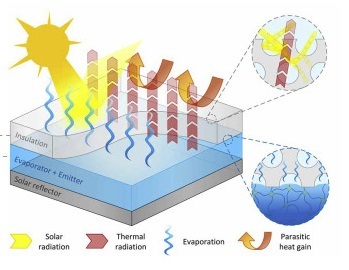Passive cooling by combining evaporation, radiation and insulation
ICER, a new passive cooling technique, can extend food shelf life by 40% in humid climates and 200% in dry climates with low water-refilling frequences.
ICER (insulated cooling with evaporation and radiation) is a passive cooling technique being developed at MIT. Passive cooling is an interesting prospect for meeting global cooling needs in terms of thermal comfort or food and pharmaceutical preservation. Passive cooling has a low carbon footprint and consumes little electrical energy.
ICER is unique in combining evaporative cooling techniques with radiative cooling.
The ICER is composed of a solar reflector, a water-rich and IR-emitting evaporative layer, and above all a vapour-permeable insulating layer, which allows the sun’s rays to be reflected.

ICER has been tested under unfavorable climatic conditions for this type of system, with high relative humidity and low altitude.
Indeed, air that is unsaturated with moisture can absorb a certain additional amount of water vapour, in which case the heat contained in the air is absorbed by the vaporisation of the water. Evaporative cooling is therefore particularly interesting in regions with hot and dry climates. Conversely, the evaporative cooling potential decreases and tends to be nil when air is close to humidity saturation levels.
The ICER achieved below-wet-bulb temperatures (9.3°C below ambient), which is not possible with pure evaporation. The insulation layer has allowed a very low water consumption.
The ICER delivered an ambient cooling power of 96 W/m² at RH = 44.0% and 86 W/m2 at RH = 50.9% around solar noon.
The ICER demonstrated a 300% enhancement in daytime cooling power compared to a state-of-the-art radiative cooler used under the same conditions.
A heat transfer model showed that ICER has great potential for saving food and energy over a wide range of climatic conditions.
More information are available at the following link.
